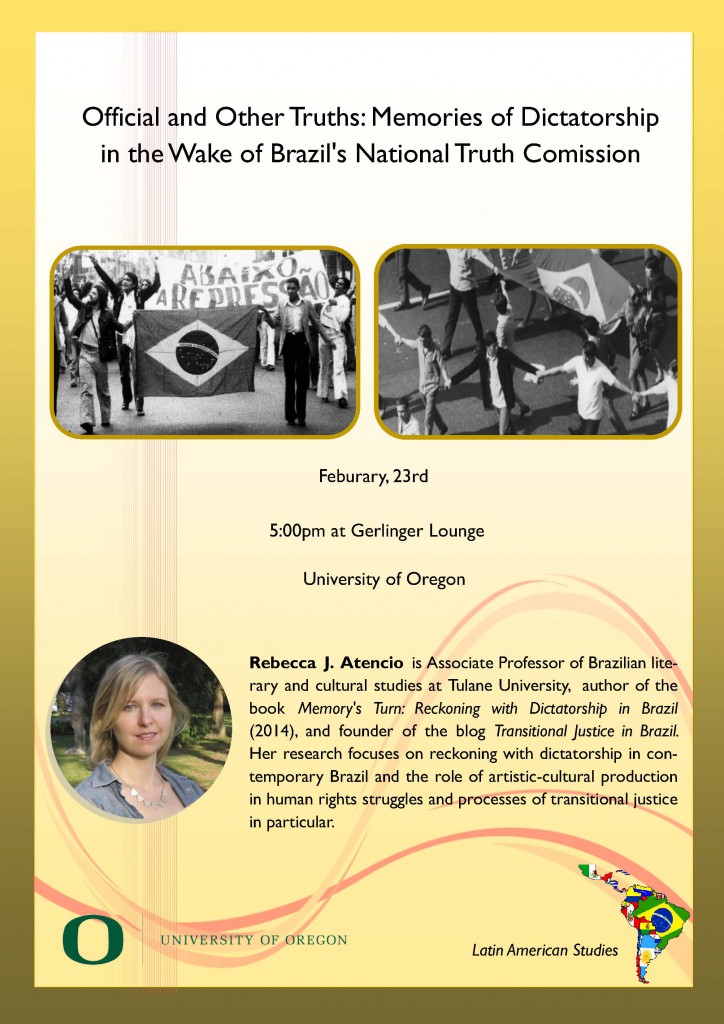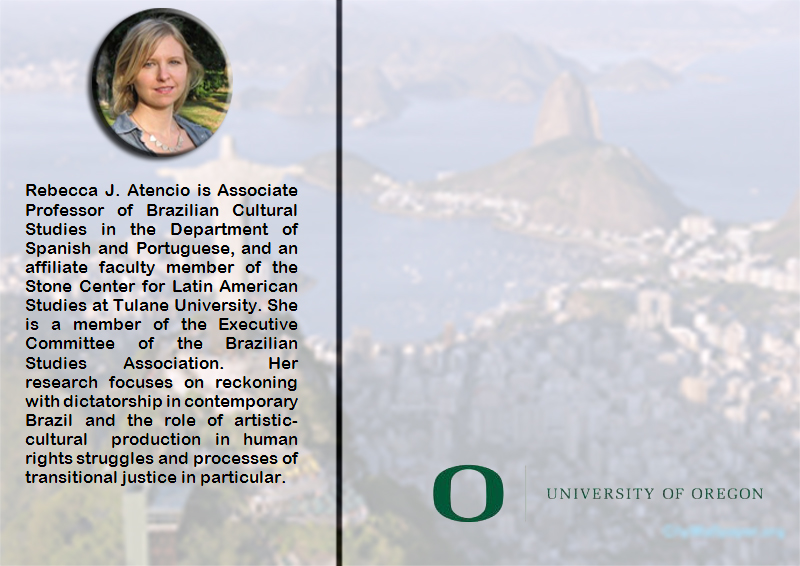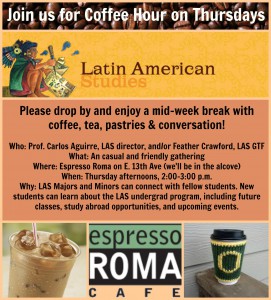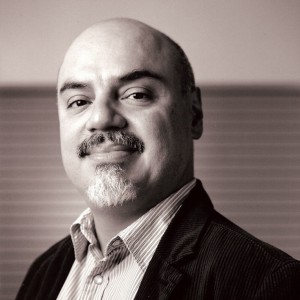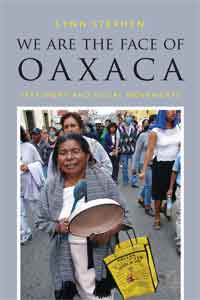Events
The Latin American Studies Program at the University of Oregon features Prof. Rebecca Atencio from Tulane University
“Official and Other Truths: Memories of Dictatorship in the Wake of Brazil’s National Truth Commission.”
Monday, February 23, 2015, at 5:00 pm.
Gerlinger Lounge
Faculty Workshop on “Researching Human Rights in Latin America: Challenges, Resources, and Strategies.”
Tuesday, February 24, 2015, from 12 p.m. to 1:30 p.m.
EMU Metolius Room
Rebecca J. Atencio is Associate Professor of Brazilian Cultural Studies in the Department of Spanish and Portuguese, and an affiliate faculty member of the Stone Center for Latin American Studies at Tulane University. She is a member of the Executive Committee of the Brazilian Studies Association. Her research focuses on reckoning with dictatorship in contemporary Brazil and the role of artisticcultural production in human rights struggles and processes of transitional justice in particular.

6TH ANNUAL GRADUATE STUDENT RESEARCH FORUM
FEBRUARY 20TH | 11:45 am-12:45 pm | FORD ALUMNI CENTER
Brazil: Favelas, Gender, Planning, and the World Cup
Presenters:
Emily Brown (Community & Regional Planning); Fabio Andrade (Community & Regional Planning); Jaleel Reed (Environmental Sciences); Shannon East (International Studies)
Description:
Favelas throughout Brazil house some of the nation’s lowest-income residents. Residents of these low-income, high-risk communities often find themselves trapped in a cyclical pattern of crime as a means to survive. Brazilian favelas are often internationally notorious for their violence and poverty but also feature a rich culture and strong community relationships. Because of recent increases in international tourism and the 2014 World Cup, these communities have been receiving more attention. Controversial favela tourism is becoming more popular, and many residents in cities featuring World Cup matches rented out their homes to visitors during the event. The Brazilian government received bad press after entire communities were forcibly displaced to make way for pre-event construction. Panel members discuss social and environmental justice issues associated with community displacement and favela tourism in Rio de Janeiro and Salvador, Brazil, such as increased housing costs and continued displacement. The panel ends on a positive note: one member will discuss ongoing research on the potential use of music and dance to decrease violence and empower marginalized young women in the favelas of Rio de Janeiro. Another member will discuss first-hand experience collected while working for the City of Salvador prior to the World Cup, ongoing research on participatory planning and governance models, specifically in the areas surrounding the World Cup stadium, and a comparative study with a model used in the United States.
Bartolomé de las Casas Lecture in Latin American Studies
Professor Stefano Varese (Native American Studies, UC Davis) will deliver the 2014 Bartolomé de las Casas Lecture in Latin American Studies. His talk, entitled “THE RIGHT TO RESIST DEVELOPMENT: ETHNOCIDE AND ECOCIDE IN AMAZONIA,” will take place on WEDNESDAY, MAY 28, AT 2 PM, in the Ford Lecture Hall at Jordan Schnitzer Museum of Art.
STEFANO VARESE is Emeritus Professor in the Department of Native American Studies and Director of the Indigenous Research Center of the Americas at the University of California, Davis. He obtained his PhD at the Pontificia Universidad Católica del Perú and taught at the Universidad Nacional Mayor de San Marcos, in Lima. In the 1970s Varese worked for the Division of Native Communities of the Amazonia in Peru. Later, he moved to Oaxaca, Mexico, where he headed “Culturas populares,” a unit of the Secretary of Education devoted to the promotion of Indigenous development. He implemented a number of projects, from bilingual-bicultural education, to artisan production, and to novel forms of political organization. In the early 1990s he moved to Davis and became a member of the Department of Native American Studies while also continuing his involvement with Indigenous organizations, especially the Frente Indígena Oaxaqueño Binacional (FIOB). His scholarly work has focused on Indigenous community development and self-determination, human rights, transnational Indigenous migration and identity, and Indigenous epistemology. He was the recipient of the 2013 LASA/Oxfam America Martin Diskin Award. His publications include Witness to Sovereignty: Essays on the Indian Movement in Latin America (2006) and Salt in the Mountain: Campa Asháninka History and Resistance in the Peruvian Jungle (2004).
For further information please contact Carlos Aguirre at caguirre@uoregon.edu or 541-346-5905.
Latin American Studies Coffee Hour
Thursdays at Espresso Roma
Please join us every Thursday of Spring Term, between 2:00 and 3:30, for an informal gathering of students, faculty, and friends of the program. This will be a space for fun and interesting conversations and for sharing information about events, courses, and opportunities to learn more about Latin America.
Come for free coffee and pastries and help build our intellectual community!
The Role of Public Art in the Oaxaca Rebellion of 2006
Wednesday, March 5 at 2 p.m.
Jordan Schnitzer Museum of Art, Ford Lecture Hall
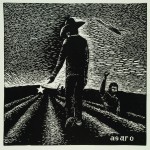 César Chávez Victoria, artist and member of the ASARO (Asamblea de Artistas Revolucionarios de Oaxaca/The Assembly of Revolutionary Artists of Oaxaca) collective, will discuss the founding of the group and its role in the 2006 Oaxaca Rebellion. This year marks the 8th anniversary of the collective’s commitment to engendering social change through art.
César Chávez Victoria, artist and member of the ASARO (Asamblea de Artistas Revolucionarios de Oaxaca/The Assembly of Revolutionary Artists of Oaxaca) collective, will discuss the founding of the group and its role in the 2006 Oaxaca Rebellion. This year marks the 8th anniversary of the collective’s commitment to engendering social change through art.
The contents of this public presentation were developed under a grant from the Undergraduate International Studies and Foreign Language (UISFL) Program, International Studies Division, U.S. Department of Education. However, those contents do not necessarily represent the policy of the Department of Education, and you should not assume endorsement by the Federal Government. Additional support was provided by the College of Arts and the Jordan Schnitzer Museum of Art.
Truth, Justice, and the Power of Imagination: A Latino Writer’s Transborder Journey
by Héctor Tobar
7:00 p.m. Thursday, February 13
Knight Library Browsing Room
Héctor Tobar is a columnist for the Los Angeles Times, a Pulitzer Prize–winning journalist, and a novelist. He is the author of The Tattooed Soldier (2000) and Translation Nation: Defining a New American Identity in the Spanish-Speaking United States (2006). His most recent novel, The Barbarian Nurseries (2012), won the California Book Award Gold Medal for Fiction for 2012. The son of Guatemalan immigrants, he is a native of the city of Los Angeles.
Ex-president Michelle Bachelet wins Chile poll run-off
Left-wing candidate Michelle Bachelet has been elected Chilean president for a second time by a wide margin.
BBC America
With almost all the votes counted, Ms Bachelet had 62% against 38% for Evelyn Matthei, a former minister from the governing center-right coalition.
Ms Bachelet first served from 2006 to 2010, but under Chile’s constitution she could not stand for a second consecutive term.
She narrowly missed out on outright victory in the first round last month.
BBC Mundo’s Ignacio de los Reyes said that hundreds of people applauded Ms Bachelet when she took to the stage outside the headquarters of her coalition in the center of Santiago, some even cried with joy.
Many of them were women, members of the gay and lesbian community and environmentalists – some of the core groups that supported Ms Bachelet throughout her campaign.
In her victory speech, Ms Bachelet, 62, said she would carry out “deep reforms needed in Chile”, but she assured voters she would do so “responsibly”.
“Today in Chile we’re in the majority and it’s time we moved forward to fulfill the dream we all have, to again believe in ourselves, and to believe that there’s strength in unity,” she said.
“I am proud to be your president-elect today. I am proud of the country we’ve built but I am even more proud of the country we will build.”
Ms Bachelet is now set to become the first leader in Chile to serve two terms since the military rule of Gen Augusto Pinochet from 1973 to 1990.
Upon hearing the news, her supporters took to the streets to celebrate, waving flags and sounding car horns in the capital, Santiago.
Her rival, Evelyn Matthei, 60, conceded defeat and congratulated Ms Bachelet in person.
Coming close to tears, Ms Matthei told her supporters that her “deepest and honest desire is that things go well for her [Michelle Bachelet]”.
“No one who loves Chile can want anything else,” Ms Matthei said.
Ms Bachelet said she and Ms Matthei shared the will to serve their people
Ms Bachelet thanked Ms Matthei for her good wishes and said that both shared a love for their homeland and a willingness to serve its people.
‘Radical’ manifesto
A pediatrician by training, Ms Bachelet won 47% of the vote in the first round on 17 November. Ms Matthei secured 25%.
Ms Bachelet leads an alliance of her Socialist Party, Christian Democrats and Communists and has campaigned on policies designed to reduce the gap between rich and poor.
Chile is one of the richest countries in Latin America, but millions have staged protests over the past few years to push for a wider distribution of wealth and better education.
Ms Bachelet wants to increase taxes to offer free university education and reform political and economic structures dating from the dictatorship of Gen Pinochet.
Her manifesto this time is much more radical than before, the BBC’s Gideon Long in Santiago reports.
Ms Bachelet was constitutionally barred from serving a second successive term but was very popular when she left office.
Ms Matthei entered the race after two candidates of the center-right alliance resigned earlier this year – one for alleged financial irregularities, the other one after struggling with depression.
She called for a continuation of the policies of outgoing President Sebastian Pinera, asserting that Chileans are “better off” now than when he came to power four years ago.
Shared childhood
As children in the 1950s, the current rivals were neighbours and used to play together on the airbase where their fathers, both air force generals, worked.
Ms Matthei’s father, Fernando, rose through the ranks to run a military school.
Michelle Bachelet’s father, Alberto, had a job in the Socialist administration overthrown by Gen Pinochet in the 1973 coup.
He died in 1974 of a heart attack while in custody. An investigation concluded that the 51-year-old general had probably died of heart problems aggravated by torture at the military academy.
A judge ruled earlier this year that Gen Matthei had no knowledge of or involvement in the torture.
Glimmers of Hope in Guatemala
From Silence to Memory: Revelations of the Archivo Histórico de la Policía Nacional
with a foreword by Carlos Aguirre and a preface by Kate Doyle
University of Oregon Libraries, 476 pp., available at scholarsbank.uoregon.edu
New York Review of Books, December 5, 2013
Larry Towell/Magnum Photos
The Kaibiles, a special counterinsurgency force of the Guatemalan army that has been accused of human rights violations, Guatemala City, 1988
A few weeks ago in Guatemala, I participated in a long-overdue commemoration. September 14 was the one-hundredth anniversary of the birth of President Jacobo Árbenz, a former army officer who was elected in 1950, then ousted in 1954 in a coup organized by the CIA, and replaced by a military junta. His name has been taboo in Guatemala for most of the time since then. Many in the ruling elite still consider the causes he championed—land reform above all—repugnant and mortally dangerous. September’s commemoration included speeches, conferences, and a vote by the city council in Quetzaltenango, where Árbenz was born in 1913, to name the local airport in his honor.
This commemoration unfolded at the end of a year during which Guatemalans’ attention was focused on a very different period of their history, the horrifically violent 1980s. In May a Guatemalan court convicted General Efraín Ríos Montt, who was head of state from 1982 to 1983, of genocide. A higher court quickly annulled the verdict, but nonetheless it was a spectacular triumph for victims of the thirty-six-year civil war that broke out soon after Árbenz was overthrown.
While I was in Guatemala, I visited a chilling police archive that reflects yet another aspect of this country’s attempt to confront its past. It came to light after investigators entered a Guatemala City police compound in 2005 and found, piled in moldy and vermin-infested heaps, nearly 80 million documents comprising a minute history of the National Police from 1882 to 1997. I was led past teams of archivists who, wearing gloves and hairnets, are meticulously digitizing this collection. They have scanned about 15 million documents so far. A single-volume collection of highlights was published in Guatemala two years ago, and an English translation,From Silence to Memory, has just appeared. It is a cold but intimate self-portrait of the terror state.
This is an almost unimaginable chain of events for Guatemala: discovery of the police archive and publication of its contents; a genocide verdict against General Ríos Montt; and the reemergence of Árbenz from historical oblivion. It cannot be taken to mean that Guatemala has matured as a nation. Guatemala is no longer at war, but its democracy is one of the weakest in the hemisphere. Its politics is corrupt. The range of choices at election time is narrow, and Congress is splintered and frozen into immobility. Drug gangs have penetrated government. Violence is endemic. Entire populations of indigenous people are still suffering from the effects of political violence. Millions subsist in acute poverty.
Yet as the civil war fades into history—peace accords were signed in 1996—Guatemala’s old power structure is losing its grip. All three of the institutions that have run the country as a virtual triumvirate for most of its existence—the army, the wealthy elite, and the Catholic Church—are weaker than at any time in the last half-century. Revelations about the army’s crimes have cost it much of its political prestige. The traditional ruling class, dominated by old coffee-farming families, is being challenged by new groups that have become rich through drug trafficking or by winning Internet and cell phone contracts. Catholicism is weakening as evangelical sects grow in size and influence.
In this fluid environment, new social forces are emerging. Members of the postwar generation seem eager to learn about Guatemala’s past and help guide its future. The middle class is growing. Movements advocating for the rights of indigenous peoples are active and growing. New forms of communication and social media have made it impossible for the repressive apparatus to function with the impunity it has enjoyed for generations.
One public discussion about Árbenz during the September commemoration was held in Guatemala City at the Sophos bookstore, which has become a center of intellectual life. As the audience gathered, the owner, Philippe Hunziker, told me that this is an “interesting moment” for his country. “The power of the traditional elite is no longer absolute,” he said. “It’s still strong enough to prevent any left-oriented political force from competing for power in elections, but we are seeing possibilities that have not existed in Guatemala for a long time.”
The overthrow of Jacobo Árbenz in 1954 was among the most ill-conceived CIAoperations. In the hypercharged atmosphere of the early cold war, President Dwight Eisenhower, Secretary of State John Foster Dulles, and his brother, Director of Central Intelligence Allen Dulles, decided that Guatemala threatened the United States. The United States had an army 140 times the size of Guatemala’s, a territory ninety times larger, and a population fifty times greater. Nonetheless the land reform program Árbenz advocated, his friendship with Guatemalan Communists, and opposition to him in Washington from the powerful United Fruit Company convinced the Dulles brothers—who had represented United Fruit as private lawyers at Sullivan and Cromwell—that he was too dangerous to be tolerated.
Árbenz had been drawn to Marxism before and during his presidency. The head of Guatemala’s Communist Party, José Manuel Fortuny, was among his closest advisers. He ordered weapons from Czechoslovakia after the United States cut off supplies to his army. Though he may have wished to stay out of the cold war, he seemed to have no understanding of the intense fear of Communist expansionism that gripped the United States in the 1950s. He never realized how his actions would look from Washington’s cold war perspective.
The overthrow of Árbenz led to protests, repression, rebellion, and civil war. Several guerrilla groups emerged. Many of their leaders were inspired by Fidel Castro’s revolution in Cuba, and Castro gave them various forms of help over the war’s long course. Some groups drew support from indigenous people, including the Ixil Maya, who have been known for rebelliousness since the days of the Spanish conquest. At the rebellion’s peak in the 1970s and 1980s, Guatemalan guerrillas considered themselves allies of the Sandinistas of Nicaragua and leftist rebels in El Salvador.
This conflict produced a series of dictators, of whom Ríos Montt is now the most notorious. His trial marked the first time a former head of state has been convicted of genocide in his own country. Hundreds of Guatemalans, many in the clothes of indigenous people, attended the trial. Dozens wrote blogs or sent tweets from the courtroom. Ninety-four witnesses testified, often in gruesome detail. Damning documents were projected onto a large screen in the courtroom. Ríos Montt watched it all. Many others, nearby and far away, followed the trial on a live video feed. The conviction was met by an outpouring of jubilation—but also a quick backlash.
Leaders of Guatemala’s notoriously reactionary business elite did not seem troubled when prosecutors indicted Ríos Montt for directing a genocidal campaign against the Ixil Maya. He was never part of their inner circle, and they felt no urge to rescue him. As the verdict approached, however, Zury Ríos, the daughter of Ríos Montt and a member of Congress, and several other children of retired military officers met with powerful business leaders. They warned: if you allow Ríos Montt to be convicted, you may be next.
Prominent businessmen had been members of the Council of State, a body Ríos Montt created to help him run the country in the early 1980s. After talking with Zury Ríos and her associates, several of them commissioned a study to determine if they might be held responsible for collaborating with genocide. The analyst they employed told them it was possible. “If you follow the chain of command to the president, the Council of State could also be put on trial,” he told a Guatemalan journalist. “Anyone who collaborated with the army in any way could be forced to answer in court.”
In view of this threat, twelve business leaders, including six former cabinet ministers and two former vice-presidents, issued a declaration asserting, “The charge of genocide is a legal fabrication that has nothing to do with the wish of victims to dignify their lost loved ones.” They followed this with a sustained publicity campaign using the slogan “Guatemala Is Not Genocidal.” President Otto Pérez Molina, a retired general, said former guerrilla leaders should be on trial instead of Ríos Montt because “it was the guerrillas who brought war to the Ixil triangle,” referring to a region where guerrillas hid and many thousands of Indians were killed. But he did not stop the trial from proceeding.
The guilty verdict, which came on May 10, with an eighty-year prison sentence, was a judicial affirmation of Ríos Montt’s role in one of the most murderous military campaigns in Latin American history. An estimated 200,000 people were killed, and a limited United Nations–sponsored commission later concluded that 93 percent of them died at the hands of government forces. Ten days after the verdict was pronounced, the Constitutional Court, citing an error in legal procedure, annulled it. That pleased business leaders who had been members of Ríos Montt’s Council of State. It also calmed the fears of dozens of well-to-do Guatemalans who, during the 1980s, flew combat support missions and carried out bombing raids for the army in their own planes and helicopters.
Yet the annulment barely dampened the sense of victory that activists felt at the conviction. They had secured a legal judgment of genocide, underpinned by a 718-page verdict citing an overwhelming array of evidence. Their legal victory was canceled, but their moral triumph remains clear.
Much of the best news coverage of the Ríos Montt trial, including the first published account of how and why the business elite became involved, was produced by a remarkable new online journal called Plaza Pública. Founded in 2011 and now employing ten full-time reporters, it does not rely on advertising; most of its expenses are paid by the Rafael Landívar University in Guatemala City, where it is based, with contributions from George Soros’s Open Society Foundations and a Dutch foundation, Hivos. Its director, Martín Rodriguez Pellecer, who is thirty years old, has emerged as one of the country’s leading reporters. He and his colleagues reject the codes of silence that paralyzed Guatemalan journalism for decades. In September, Rodriguez Pellecer participated in the Árbenz commemoration. Afterward I asked him how he saw his country at this moment. He told me it still suffers from “deep problems that are the result of inequality and the absence of the state,” but is also changing—thanks in part to the emergence of peasant cooperatives organized by groups ranging from weavers to coffee growers. “There is a growing middle class,” he said,
both in Guatemala City and in the interior, much of it organized in prosperous and democratic cooperatives. These cooperatives are producing 10 percent of our gross national product, and have political influence. The other area where there has been improvement is the justice system…. We now have important people in prison, including drug traffickers, corrupt government officials, major business figures who committed tax fraud, and soldiers responsible for responsible for massacres.
A good part of our society is ready to confront our history, but the circles of power are not. That’s why the verdict against Ríos Montt was annulled. It was a judgment about a crime that permeates our society, since genocide is the ultimate expression of racism. In the end it was a positive step. Guatemala is still plagued by racism and machismo, but much less than in the past.
If the young generation of Guatemalans seems one promising force born out of the conflict, newly invigorated indigenous movements are another. Descendants of Mayan Indians make up much of Guatemala’s population. Since the era of Spanish conquest they have been subject to continued oppression, and they were the principal victims of the civil war. Today they are demanding rights with a fervor never before seen in Guatemala. During the last few years, foreign-operated mines have been a focus of their protests.
One conflict is over the Marlin mine, two hundred miles northwest of the capital. It is operated by a Canadian company, Goldcorp, under a concession granted by the Guatemalan government. In 2010, according to Goldcorp, the mine produced its millionth ounce of gold, and it “continues to generate significant cash flow.” On its website, the company asserts that it is guided by “a desire to work for the mutual benefit of all stakeholders” and seeks “to conduct our business in a socially, economically and environmentally respectful and responsible manner.”
Protests against mining have emerged in several Latin American countries in recent years. Those in Guatemala are notable for their intensity, the participation of indigenous communities, and the international attention they have attracted. A film about this conflict, Gold Fever, had its premiere at the Teatro Nacional in Guatemala City in April and has since been shown at festivals, theaters, and campuses in more than twenty countries. In 2011, after visiting Guatemala, the United Nations rapporteur for indigenous people, James Anaya, expressed “grave concern” over the “alarming lack of legal protection for the rights of indigenous people over their traditional lands and territories, which leaves Guatemala lagging behind other countries in the region that have made progress in that regard.”
Currently in Guatemala, the business activities underway in the traditional territories of the indigenous peoples have generated a highly unstable atmosphere of social conflict, which is having a serious impact on the rights of the indigenous people and threatening the country’s governance and economic development.
The repercussions include numerous allegations concerning the effects on the health and the environment of the indigenous people as a result of the pollution caused by the extractive activities; the loss of indigenous lands and damage to indigenous people’s property and houses; the disproportionate response to legitimate acts of social protest, and the harassment of and attacks on human rights defenders and community leaders.
Mining provides the government with desperately needed tax revenue. Few benefits, however, trickle down to people who live near mines. They say mining contributes to disease and environmental destruction, and exacerbates social tensions. In April and May a protest against silver mining in San Rafael Las Flores, fifty miles southeast of the capital, escalated into violence and the death of a police officer and a protester, leading President Pérez Molina to impose a thirty-day state of siege in the region, limiting residents’ right to meet and move freely. The political elite continues to view protest movements as antigovernment subversion rather than legitimate expressions of grievance.
Because the country is still not a safe place to live, the recovery of history is difficult. Yet the legacy of terror is on full view at the Historical Archive of the National Police. This archive is a deeply impressive symbol of Guatemala’s fitful effort to deal with its past.
Documents from the archive reproduced in From Silence to Memory offer a terrifying look at the inner workings of a murderous police force. A postmortem card bears fingerprints of a victim called XX, the name under which thousands were buried. A one-sentence note introduces a list of “individuals known to collaborate with guerrillas or subversive delinquents in the Quiché region.” A surveillance photo of a student demonstration on September 20, 1978, has a cross identifying the twenty-three-year-old student leader Oliverio Castañeda de León; he was killed a month later.
In a preface to From Silence to Memory, Kate Doyle of the Washington-based National Security Archive writes:
The report also explains how an institution charged with fighting crime and guaranteeing public order could be radically re-engineered to become an instrument of terror. The decisive moment came in 1954, when the United States supported a coup against Guatemala’s democratically elected president in favor of dictatorship…. In short order, the importance of the National Police’s counter-subversive mission overcame their ordinary law enforcement functions, fatally infecting the culture of the institution.
This is the largest police archive to have emerged from Latin America. Smaller ones have been opened or found in several other countries, but access to them is restricted. In Argentina, for example, considerations of privacy prevent the release of many documents to researchers. The Guatemalan archive is open to any citizen. Documents found here have led to trials in which former police officers, including some of high rank, have been given long prison terms for political killings and other offenses.
From Silence to Memory is divided into four sections, each in the form of a richly documented essay. The first traces the history of the National Police and its degeneration into an instrument of political repression. The second describes the police force’s relations with its security partners, including the army and United States advisers. The third documents the tactics police used to control the population. I was struck by the final section, which presents the detailed cases of nine victims. One of the nine was my first Guatemalan friend.
During my visits to Guatemala in the late 1970s, I came to know a dynamic and ambitious politician, Manuel Colom Argueta. As a student he had organized protests against the military regime the United States supported after overthrowing Árbenz. He formed a left-leaning political party called the United Revolutionary Front, served four years as mayor of Guatemala City, and planned to seek the presidency in 1980. Pleased that an American had taken an interest in his country’s politics, he spent hours talking to me about its history, the nature of the conflict into which it had fallen, and his hopes for its future. On March 22, 1979, he and his two bodyguards were shot dead as they drove through Guatemala City. He was forty-six years old.
From Silence to Memory reports that researchers at the Historical Archive of the National Police have found 117 documents showing that the police were “involved in a political persecution of Manuel Colom Argueta that lasted 22 years.” They include surveillance reports, notes about Colom’s foreign travels, license plate numbers of motorcycles that he reported as having followed his car, and notes describing him as Communist and a terrorist, neither of which he was. An account of his murder says that the death squad was composed of at least three cars and two motorcycles, and that Colom fled from the scene but was killed when “a well-built young man carrying a machine gun dismounted in order to finish the victim off.” The report concludes that Colom was marked for death because of “his role as a political leader with roots in broad sectors of the population,” and because he “seemed to be capable of achieving electoral success by offering a different option on the political spectrum of that era.”
This assassination and others allowed generals to maintain their control of the presidency. With help from Argentina, South Africa, Taiwan, Israel, and the United States—President Reagan praised General Ríos Montt as “a man of great personal integrity” who had been given “a bum rap” as a human rights abuser—the army launched a scorched-earth campaign against rebels and their presumed supporters. Nearly all of the estimated 200,000 victims were civilians, and according to the UN investigating commission, 83 percent of them were indigenous people. This murderous campaign became possible after security forces cut down virtually the entire class of emerging civilian leaders, symbolized by Colom Argueta.
Although no documents in the police archive contain orders to kidnap or kill, some are damning enough to have led to convictions and jail sentences. There is no direct evidence of who abducted the labor leader Edgar Fernando García in 1984, for example, but an order was found citing four officers for commendation after an “operation” launched at a particular time and place in Guatemala City. Investigators knew that García was abducted at that time and place. Two of the implicated officers were found and convicted, along with two of their superiors, one of whom had been director of the National Police. All were given forty-year jail sentences.
Documents found in the police archive, according to the conclusion of From Silence to Memory, trace the roots of Guatemala’s tragedy to the CIA intervention of 1954:
Several decrees issued between 1954 and 1956 are a reflection of the growing anti-communist current, bringing about the creation of various agencies of repression that were gradually integrated into, and their functions taken over by the police institution. It was then that it evolved into the National Police as it was known during the 1970s, 80s, and 90s….
The documents in the [police archive] attest to the close working relationship between the various State security forces. These coordinated activities were especially common in the context of the international struggle against communism led by the United States. In Guatemala, this persecution intensified in 1954 after the overthrow of the elected president Jacobo Árbenz and alignment with the dictates of the US respecting hemispheric security policies as laid out in the National Security Doctrine.
It is still easy, as it has been for most of the last half-century, to see Guatemala as a dark place with no exit. The deep inequality that has plagued the country since the days of conquest continues. So does the culture of violence that has enveloped Guatemala since the 1954 coup. Yet the opening of the police archive, Ríos Montt’s conviction, and the commemoration of Árbenz can be seen as a historical sequence, testifying to the resilience of a devastated society and offering glimmers of hope that were all but unimaginable just a few years ago.
We Are the Face of Oaxaca: Testimony and Social Movements by Lynn Stephen
We Are the Face of Oaxaca: Testimony and Social Movements
by Lynn Stephen
Duke University Press
(September 2013)
A massive uprising against the Mexican state of Oaxaca began with the emergence of the Popular Assembly of the Peoples of Oaxaca (APPO) in June 2006. A coalition of more than 300 organizations, APPO disrupted the functions of Oaxaca’s government for six months. It began to develop an inclusive and participatory political vision for the state. Testimonials were broadcast on radio and television stations appropriated by APPO, shared at public demonstrations, debated in homes and in the streets, and disseminated around the world via the Internet.
The movement was met with violent repression. Participants were imprisoned, tortured, and even killed. Lynn Stephen emphasizes the crucial role of testimony in human rights work, indigenous cultural history, community and indigenous radio, and women’s articulation of their rights to speak and be heard. She also explores transborder support for APPO, particularly among Oaxacan immigrants in Los Angeles. The book is supplemented by a website featuring video testimonials, pictures, documents, and a timeline of key events.
About The Author
Lynn Stephen is Distinguished Professor of Arts and Sciences, Professor of Anthropology, and Director of the Center for Latino/a and Latin American Studies at the University of Oregon. She is the author of Transborder Lives: Indigenous Oaxacans in Mexico, California, and Oregon and Zapotec Women: Gender, Class, and Ethnicity in Globalized Oaxaca, both also published by Duke University Press.
